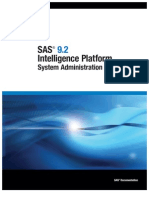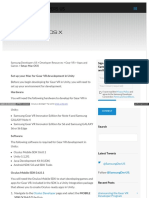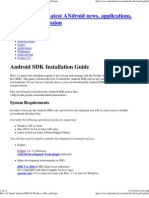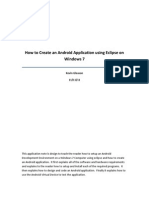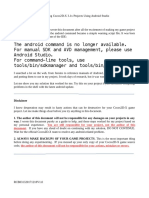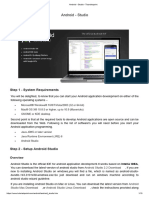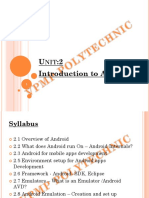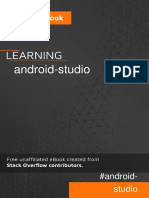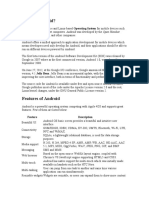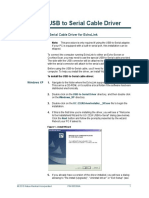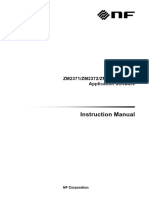COMP3130 Week 1 Workshop
COMP3130 Week 1 Workshop
Uploaded by
Emma HendersonCopyright:
Available Formats
COMP3130 Week 1 Workshop
COMP3130 Week 1 Workshop
Uploaded by
Emma HendersonOriginal Description:
Original Title
Copyright
Available Formats
Share this document
Did you find this document useful?
Is this content inappropriate?
Copyright:
Available Formats
COMP3130 Week 1 Workshop
COMP3130 Week 1 Workshop
Uploaded by
Emma HendersonCopyright:
Available Formats
Faculty
of Science and Engineering
Department of Computing
COMP3130 Mobile Application Development
Workshop Week 1
Setting up your React Native environment
These activities are to be done on your laptop.
By the end of this workshop, you should be able to
1. Set-up React Native CLI environment based on your Development OS and Target OS
a. Installation of a package manager
b. Node server
c. JDK
d. Android Studio
e. X-code and CocoaPods for MacOS
2. Set-up Expo CLI
3. Install Expo on your phone (from App store/Google Play)
4. Set-up Visual Studio Code and install extensions
5. Create your first expo project and learning to execute them in
a. Expo Client on your phone
b. Web browser
c. Android Emulator
d. iOS Simulator
6. Publishing your expo project
7. Set up your Figma educational account for Wireframing and Mockups
COMP3130 Week-1 Workshop 1
Follow the instructions below and set up your react native environment
Step 1: React-native CLI Installation
Click here for more information. When you access the link you will see a screen like the image
below. Click on React Native CLI QuickStart and choose your OS. Please note you can have both
Android Studio and X-Code on a Mac OS (please install both), whereas you could only use
Android Studio on a Windows OS. The installation instructions are different, please ensure all
the steps are completed. Also read the notes below to help you understand what each of the
components are used for.
If you follow the instructions, by the end of it you will have these installed on your system
1. A package manager (Chocolatey for Windows, Homebrew for MacOS) using which you
will install many other packages and tools that are required
2. Node server (Node.js as it is usually referred to) for executing the applications
3. JDK since applications would require this to run
4. Watchman on MacOS for better performance
5. Android development environment (Installation of Android Studio (standard
installation), Installation of Android SDK (10) and configuring the environment
variables)
6. iOS development environment (only for Mac OS users- please install XCode and
CocoaPods which is a library manager for XCode Projects. Please note that XCode
requires your Mac OS to be of v10.15.4 or later)
7. Please do not install react-native cli as this has to be done for each of the projects locally.
COMP3130 Week-1 Workshop 2
Step 2: Expo CLI Installation
You will now have to install the Expo CLI. In the same link, click on Expo CLI QuickStart
For Expo, please check the version of node that you are running using your terminal and the
node -v command
You have to have a version of at least 12. To upgrade, you need to use the command
npm update and that should update your node to the latest version.
Step 3: Install Expo Client on your phone. This would help to run the app on your phone.
Step 4: Install a Code Editor of your choice such as Atom or VS Code. Click here to download VS
Code. VS Code is more powerful and this is something that we will be using in this unit.
Once you install VS Code, add extensions in there
On the left panel, click on the extensions tab and search for the following extensions and install
them
1. React Native Tools from Microsoft
2. React-Native/React/Redux snippets for es6/es7 from EQuimper
3. Material Icon Theme from Philipp Kief
4. Prettier from Prettier
There are some visuals on the next page to help you understand the extensions tab
COMP3130 Week-1 Workshop 3
After Installation of those,
1. Click on Code-> Preferences-> Settings, Search for FormatOnSave and ensure the
checkbox is selected
2. Click on View-> Command Palette-> Type Shell Command->Select Install 'code'
command in PATH and once that is selected, you will have your keyboard shortcut to
access the codes of a project through Terminal
You’ve your environment ready now and you will be creating your expo application next.
COMP3130 Week-1 Workshop 4
Creating your First Expo Project:
On your laptop, create a folder named COMP3130 and use this to store all your react native
projects.
Using your terminal cd into the folder
Once you are in the folder, type expo init MyFirstProject
This will prompt you to choose a template. We will be using the Managed workflow (blank
option) which helps to create your expo project. The instructions on how to run the project will
also appear.
Let’s do this a bit different through VS Code Editor. To run your project,
1. Cd into the project directory
2. Type code . to open the codes of your project through VS Code.
3. The project folder will now open in VS Code and you will see all the subfolders and files
COMP3130 Week-1 Workshop 5
Click on App.js to the see the code of the screen that will be executed when we run the
app
4. On VS Code Editor, click on View-> Terminal and this should open up a terminal on VS
Code Editor
5. On your terminal type the command npm start and this will open a browser where you
can see the instructions to view the app
COMP3130 Week-1 Workshop 6
Npm start command starts the server and opens the Metro Bundler which is responsible
for compiling the JS codes.
Option 1: Running the app on your phone
From the browser window, you can scan the QR code and open it on your Expo Client on your
phone and this would look something like the image below
Option 2: Running the app on a web browser:
Click on Run on a web browser option to view the executed app on your browser (which opens
in a new tab)
Option 3: Running the app on an Android Emulator:
Open Android Studio. Click on Configure->SDK Manager
COMP3130 Week-1 Workshop 7
If you have just installed Android Studio, you will have the most updated version of Android R
or Q which is good. If you want to install a prior version, you will need to select it and click on
okay so that the SDK manager can download it for you.
If you are a MacOS user, please ensure you follow the following steps
You might have to double check your Bash Profile file for the path of Android SDK and Android
platform tools. To do this, open a new terminal window and type the command code
~/.bash_profile
This will open the bash_profile file in VS Code
In your Android Studio, again open your SDK Manager (Configure-> SDK Manager) and copy the
path from SDK Manager
COMP3130 Week-1 Workshop 8
To add the path of your Android SDK, to your VS Code editor, add this in this syntax:
export ANDROID_SDK=/your/path/here
I did this on my VS Code Editor based on my SDK path
export ANDROID_SDK=/Users/chaz/Library/Android/sdk
Back to your VS Code editor, add this in this syntax:
export PATH=/your/path/here/platform-tools:$PATH
I did this on my VS Code Editor based on my SDK path
export PATH=/Users/chaz/Library/Android/sdk/platform-tools:$PATH
Save your bash_profile file.
If you are using z shell, you will also have to make these changes. Using a terminal open the
following file using VS Code code ~/.zshrc
Add the two lines you added in your bash profile to this file as well and save it.
Kill your terminal and run the command adb. If you see a message “Command not found”, there
has been an error and redo the steps above and try again. Else, you should see messages like the
image below
More info here, if you are interested
The next step is to configure our Emulator. Click on Configure-> AVD Manager
This is your Android Virtual Device Manager that allows you to create your Emulator
Click on Create a Virtual Device and add an Emulator that has a play store installed. I have
added a Pixel 4 with Android Q as my OS on the Emulator. Click on Download and this should
take a while to install
COMP3130 Week-1 Workshop 9
Once you click okay, it will create an emulator for you to use. Please ensure this is open
before you run the app. You can access the emulator by opening Android Studio-
>Configure-> AVD Manager and Launching the Device
When you click the Play button, it launches the Emulator. To run the app, you can either
run command a on the terminal in VS Code or you can run it from the browser by
clicking on Android Emulator. When you do this, you can see the log on the VS Code. It
downloads Expo and then runs the app
COMP3130 Week-1 Workshop 10
Option 4: Running the app on iOS Simulator:
1. Open XCode (the first time you open it, some components will be installed)
2. Click on XCode-> Preferences
3. Click on Locations-> Command line tools and select XCode from the dropdown menu
COMP3130 Week-1 Workshop 11
4. Close the window. Click on XCode->Open Developer Tool and select Simulator and
this will open up a simulator.
5. Once the Simulator is open, you can change to a simulator of your choice by click on
File-> Open Simulator-> iOS and choosing a simulator of your choice. Please ensure
you have only one Simulator open at the time of execution of the app
6. To run the app, go to the terminal section on VS Code, type the command i to open
the app in the simulator. If you want to see the list of options, you can use ? to make
terminal list all the options
You will see a pop up to open the app on expo, click on Open and that will open the app on Expo.
COMP3130 Week-1 Workshop 12
Publishing the project
1. Create an account on expo.io
https://expo.io/signup
You can publish your projects under the handle you create
2. Click on Publish or republish project on your Metro Bundler page (Local host one)/
through the terminal. Leave the optional text boxes empty and click on Publish Project.
The first time, the project is published, it takes a while for the files to be uploaded.
3. It might ask you to login through your terminal (Enter your email address and
password) and your project will get published and a link will be displayed.
COMP3130 Week-1 Workshop 13
A pop-up that confirms the link that you can share. More on this subject in later weeks
Setting up the Figma Account
1. Click on https://figma.com/education
2. Click on Get Verified and register your account using your student email
3. You will be using this to create your wireframes and mockups
COMP3130 Week-1 Workshop 14
You might also like
- Simavio: Installation and Procedures ManualDocument45 pagesSimavio: Installation and Procedures Manualeduardo ruizNo ratings yet
- MicroPython Program ESP32 - ESP8266 Vs Code and Pymakr - Random Nerd TutorialsDocument38 pagesMicroPython Program ESP32 - ESP8266 Vs Code and Pymakr - Random Nerd TutorialsPablo Gonzalez Robles100% (1)
- Phone GapDocument7 pagesPhone GapArpit SatijaNo ratings yet
- C# Programming Illustrated Guide For Beginners & Intermediates: The Future Is Here! Learning By Doing ApproachFrom EverandC# Programming Illustrated Guide For Beginners & Intermediates: The Future Is Here! Learning By Doing ApproachNo ratings yet
- LogChief 2.2 Install GuideDocument22 pagesLogChief 2.2 Install GuideEl Zurdo ObregonNo ratings yet
- SAS ADmin PlatformDocument387 pagesSAS ADmin Platformodezi455No ratings yet
- Ionic TutorialDocument14 pagesIonic TutorialPiedmondNo ratings yet
- 4android EclipseDocument7 pages4android EclipseAniket SaneNo ratings yet
- Construct 2 Apps 18iws16Document15 pagesConstruct 2 Apps 18iws16Atul VasudevNo ratings yet
- Mobile Computing Lab ManualDocument63 pagesMobile Computing Lab Manualsuchdev darshanNo ratings yet
- C How To Program 9 e Before You BeginDocument4 pagesC How To Program 9 e Before You Begingus contrerasNo ratings yet
- Carspot - Dealership Wordpress Classified React Native App: Preparation and InstallationDocument13 pagesCarspot - Dealership Wordpress Classified React Native App: Preparation and InstallationJin MingNo ratings yet
- What Is Apache Cordova?: HTML CSS JavascriptDocument54 pagesWhat Is Apache Cordova?: HTML CSS JavascriptJoel NoronhaNo ratings yet
- Visual Studio CodeDocument45 pagesVisual Studio CodeRanjith100% (1)
- Samsungdeveloperconnection Developer ResourcesDocument18 pagesSamsungdeveloperconnection Developer ResourcescosminraduNo ratings yet
- How-To Install Android SDK On Windows, Mac and LinuxDocument15 pagesHow-To Install Android SDK On Windows, Mac and LinuxSalman1231100% (1)
- Config 1 AULA - Setting Up The Development Environment React NativeDocument10 pagesConfig 1 AULA - Setting Up The Development Environment React Nativemarcelo.reis25No ratings yet
- C# Hello World: First Console Application ProgramDocument7 pagesC# Hello World: First Console Application ProgramRodNo ratings yet
- How To Work With Code Blocks - TutorialDocument17 pagesHow To Work With Code Blocks - TutorialSuraz Verma100% (1)
- OBTAINING THE REQUIRED TOOLS For Developing ANDROID APLLICATIONSDocument13 pagesOBTAINING THE REQUIRED TOOLS For Developing ANDROID APLLICATIONSSuraj Kamal ShaikNo ratings yet
- How To Create An Android Application Using Eclipse On Windows 7Document13 pagesHow To Create An Android Application Using Eclipse On Windows 7ApoorvAroraNo ratings yet
- Android Assignment1-18 PDFDocument98 pagesAndroid Assignment1-18 PDFSumit SinghNo ratings yet
- cc-LAB UpdatedDocument61 pagescc-LAB Updatedjayapriya kceNo ratings yet
- 3android StudioDocument12 pages3android StudioAniket SaneNo ratings yet
- Tutorial 2 OpenCV For Android Setup Windows API8 PDFDocument9 pagesTutorial 2 OpenCV For Android Setup Windows API8 PDFAnonymous Wu14iV9dqNo ratings yet
- Lab 1: Android Development Environment: EE5415 Mobile Applications Design and DevelopmentDocument15 pagesLab 1: Android Development Environment: EE5415 Mobile Applications Design and DevelopmentCheuk Wing WanNo ratings yet
- Android - Getting StartedDocument62 pagesAndroid - Getting StartedEugene100% (1)
- Flutter 1st LectureDocument5 pagesFlutter 1st LecturekhanbalochtaunsaNo ratings yet
- Printout DocumentDocument63 pagesPrintout Documentsuchdev darshanNo ratings yet
- Department of Computer Science,: "Tools For Technical Writing and Research Data Analysis" (TTWRDA-2020)Document6 pagesDepartment of Computer Science,: "Tools For Technical Writing and Research Data Analysis" (TTWRDA-2020)venkiscribd444No ratings yet
- Cocos2D-X Compile Without Android Command With Android StudioDocument5 pagesCocos2D-X Compile Without Android Command With Android StudiosriparnachakrabortyNo ratings yet
- Creating React Native Application 1) The React Native CLI: Preparing The Android DeviceDocument7 pagesCreating React Native Application 1) The React Native CLI: Preparing The Android DeviceAnuj GuptaNo ratings yet
- Mobile App Development ManualDocument56 pagesMobile App Development Manual209X1A04D2 SHAIK ASMANo ratings yet
- MAD Lab ManualDocument81 pagesMAD Lab ManualShaik ReshmaNo ratings yet
- Android Development ToolDocument13 pagesAndroid Development Toolbhargavramkp02No ratings yet
- Android - Studio - TutorialspointDocument10 pagesAndroid - Studio - Tutorialspointpaithankarpratik3No ratings yet
- Computer Programing 2Document5 pagesComputer Programing 2Avc CcssNo ratings yet
- Eclipse IDEDocument11 pagesEclipse IDEhurairaansari781No ratings yet
- Code WarriorDocument16 pagesCode WarriorNaumanNo ratings yet
- Installing NodeJS and Running Your First Web AppDocument6 pagesInstalling NodeJS and Running Your First Web Appb.nomundariNo ratings yet
- Oops Concepts: 1. Class & Object 2. Encapsulation 3. Abstraction 4. Inheritance 5. PolymorphismDocument2 pagesOops Concepts: 1. Class & Object 2. Encapsulation 3. Abstraction 4. Inheritance 5. PolymorphismShikha NegiNo ratings yet
- Unit 2 MCADDocument36 pagesUnit 2 MCADNisarg ShrimaliNo ratings yet
- Mad Lab ManualDocument68 pagesMad Lab ManualHonnamma sp4257100% (1)
- Android Mobile Application DevelopmentDocument43 pagesAndroid Mobile Application DevelopmentprogrammerNo ratings yet
- Android StudioDocument25 pagesAndroid StudiogvhgvhgvNo ratings yet
- FSD LabDocument137 pagesFSD Labnoteshareedu01No ratings yet
- Building An Android Command Line Application Using The NDK Build Tools 593986Document9 pagesBuilding An Android Command Line Application Using The NDK Build Tools 593986fabiolmtNo ratings yet
- Mono DocumentationDocument259 pagesMono DocumentationPino AffeNo ratings yet
- Community: Search Developer Docs SearchDocument17 pagesCommunity: Search Developer Docs SearchKsridhar SridharNo ratings yet
- Tutorial On Using Android For Image Processing Projects: Downloading and Installing Java RuntimeDocument7 pagesTutorial On Using Android For Image Processing Projects: Downloading and Installing Java RuntimeAnas KhoujaNo ratings yet
- Building Your First Android App: Create A Project With EclipseDocument4 pagesBuilding Your First Android App: Create A Project With Eclipsemanoj22490No ratings yet
- Introduction To CSharpDocument29 pagesIntroduction To CSharpMihaela SandruNo ratings yet
- Installing Flutter in Windows.. Flutter Is Very New, But A Promising - by Ahmed Thaajwer - D6 Digital - MediumDocument15 pagesInstalling Flutter in Windows.. Flutter Is Very New, But A Promising - by Ahmed Thaajwer - D6 Digital - MediumBarik MaftuhinNo ratings yet
- Synopsys Syn 2016Document15 pagesSynopsys Syn 2016Himanshu PatraNo ratings yet
- What Is Android?: Alliance, Led by Google, and Other CompaniesDocument21 pagesWhat Is Android?: Alliance, Led by Google, and Other CompaniesregisanneNo ratings yet
- WritingCustomPayloads Defcon27 LabGuideDocument35 pagesWritingCustomPayloads Defcon27 LabGuideHey Dikay100% (1)
- Installing The Android Development ToolsDocument4 pagesInstalling The Android Development ToolsSergio FernandesNo ratings yet
- C# For Beginners: An Introduction to C# Programming with Tutorials and Hands-On ExamplesFrom EverandC# For Beginners: An Introduction to C# Programming with Tutorials and Hands-On ExamplesRating: 5 out of 5 stars5/5 (1)
- Evaluation of Some Android Emulators and Installation of Android OS on Virtualbox and VMwareFrom EverandEvaluation of Some Android Emulators and Installation of Android OS on Virtualbox and VMwareNo ratings yet
- Game and Graphics Programming for iOS and Android with OpenGL ES 2.0From EverandGame and Graphics Programming for iOS and Android with OpenGL ES 2.0No ratings yet
- Coding Basics with Microsoft Visual Studio: A Step-by-Step Guide to Microsoft Cloud ServicesFrom EverandCoding Basics with Microsoft Visual Studio: A Step-by-Step Guide to Microsoft Cloud ServicesNo ratings yet
- Pro-E Installation GuideDocument208 pagesPro-E Installation GuideSatheesh SekarNo ratings yet
- B0403 Chemstation Site Preparation ChecklistDocument6 pagesB0403 Chemstation Site Preparation ChecklistsubodhNo ratings yet
- MQTC v2015 MQforAdminsDocument77 pagesMQTC v2015 MQforAdminsveenaNo ratings yet
- EchoLink USB To Serial Adapter Instructions PDFDocument4 pagesEchoLink USB To Serial Adapter Instructions PDFآكوجويNo ratings yet
- ZM237x ApplicationSoftware InstructionManualDocument67 pagesZM237x ApplicationSoftware InstructionManualNeerajNo ratings yet
- Getting Started With Julia - Sample ChapterDocument24 pagesGetting Started With Julia - Sample ChapterPackt PublishingNo ratings yet
- EB8000 Manual All in OneDocument702 pagesEB8000 Manual All in OneJosueGonzalezDePalacios100% (2)
- Lupo Cosimo Scan Books Using Free Software and Digital CameraDocument18 pagesLupo Cosimo Scan Books Using Free Software and Digital CameraaquarianflowerNo ratings yet
- READ ME - Mapping File Install Guide-TK2Document10 pagesREAD ME - Mapping File Install Guide-TK2Tauã TeixeiraNo ratings yet
- HPE StoreOnce Catalyst Plug-In 1.6.0 For MS SQL Release NotesDocument8 pagesHPE StoreOnce Catalyst Plug-In 1.6.0 For MS SQL Release Notes720128atmNo ratings yet
- WIA - Network Scan GearDocument42 pagesWIA - Network Scan GearHendro NugrohoNo ratings yet
- Racattack PDFDocument246 pagesRacattack PDFTolulope AbiodunNo ratings yet
- BIOS Configuration Utility User GuideDocument19 pagesBIOS Configuration Utility User GuidecornolioNo ratings yet
- 001 PLAXIS - 2D - 2023.1 - General Information ManualDocument26 pages001 PLAXIS - 2D - 2023.1 - General Information ManualVaibhav PhalakNo ratings yet
- Total Visual Sourcebook Manual PDFDocument111 pagesTotal Visual Sourcebook Manual PDFAnonymous HGOomkn69No ratings yet
- Hpe Simplivity - Software 4.0.1 Release: Richard GreenwaltDocument70 pagesHpe Simplivity - Software 4.0.1 Release: Richard GreenwaltEsperant KayembelukusaNo ratings yet
- CentOS 6 - Install and Configure Oracle Client - Void TechnologyDocument4 pagesCentOS 6 - Install and Configure Oracle Client - Void TechnologygochorneaNo ratings yet
- Ways To Install Soft in Ubuntu - OdtDocument18 pagesWays To Install Soft in Ubuntu - OdtzeeshanNo ratings yet
- Ibm Utl Asu Asut86h-9.64 Windows x86-64Document8 pagesIbm Utl Asu Asut86h-9.64 Windows x86-64alaamakaremNo ratings yet
- Installation Manual EucalyptusDocument4 pagesInstallation Manual EucalyptusTarun TankNo ratings yet
- EZP2019+ User ManualDocument9 pagesEZP2019+ User Manualtraore falyNo ratings yet
- Simio Installation NotesDocument4 pagesSimio Installation NotesMiguel Leonardo Jimenez OrtizNo ratings yet
- DF-CLARIFY ManualDocument7 pagesDF-CLARIFY ManualaaaNo ratings yet
- Studentguide GgsDocument245 pagesStudentguide Ggsrrams_cheNo ratings yet
- SoftX3000 Software Installation ManualDocument285 pagesSoftX3000 Software Installation ManualFelix_Andres_J_1121No ratings yet
- EMS Installation User ManualDocument13 pagesEMS Installation User ManualRodrigo DelfinoNo ratings yet
- CSS II - Course Syllabus (Detailed)Document15 pagesCSS II - Course Syllabus (Detailed)Jsmjc IDNo ratings yet






